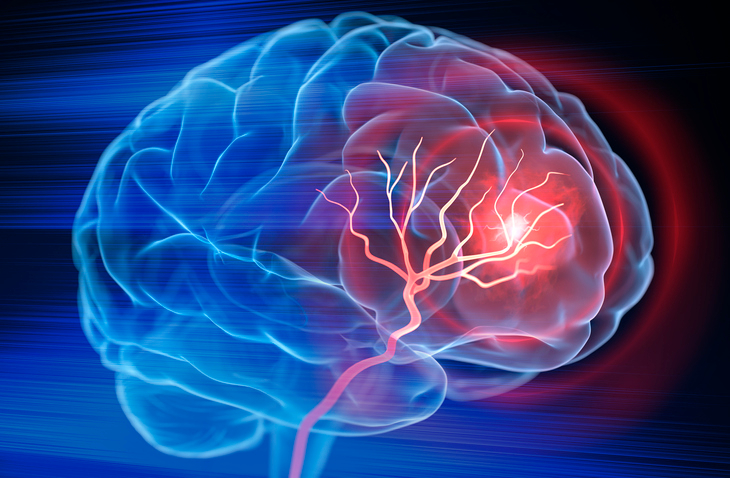Commitment + Clinical Leadership = Better Outcomes

14 Facts About Strokes
Here are 14 facts about strokes to help you learn more about strokes and the people who are affected by them.
Every 40 seconds, someone in the United States has a stroke
Someone has a stroke in the United States every 40 seconds. It is estimated every 3.5 minutes, someone will die of a stroke.1
It is estimated 1 in 4 adults will have a stroke in their lifetime
1 in 4 adults are estimated to have a stroke in their lifetime.2 Every year, it is estimated that 795,000 people have strokes. Of these, 610,000 are first strokes, and 185,000 people who survive a stroke will have another one in the next 5 years.3
Strokes occur when the blood supply is interrupted
Strokes occur when blood supply to the brain is reduced, which prohibits the brain from getting the oxygen and nutrients it needs. Brain cells will begin to die within minutes, causing people to need immediate medical attention.
People experience paralysis during a stroke
Another stroke fact is people commonly experience paralysis or numbness in their face, arms, or legs when they are having a stroke. Paralysis can be sudden and affect one or both sides of the body. Many people will raise their arms to figure out if they are having a stroke because when they raise both of their arms, one side will fall.4
Stroke is the leading cause of long-term disability
It is estimated that there are currently 4.7 million stroke survivors alive today, making strokes the leading cause of long-term disability. Strokes reduce the mobility of over half the survivors who are over 65.1
Americans spend 45.5 billion on strokes
The American Heart Association estimates that Americans spend $45.5 billion dollars on strokes, both direct and indirect costs. Of this, it is estimated $7.9 billion goes to hospital inpatient stays for strokes.5
Millions of brain cells die during a stroke
During a stroke, 1.9 million nerve cells die each minute, and the brain will age 3.6 years each hour. This results in the loss of 14 billion synapses and 7.5 million nerve fibers.6
FAST is an acronym for the warning signs and symptoms
The acronym FAST was created to help educate people about the warning signs and symptoms of a stroke. FAST stands for (F) face drooping, (A) arm weakness, (S) speech difficulty, and (T) time to call 911.7
80% of strokes are preventable
It is estimated that roughly 80% of strokes are preventable because high blood pressure is usually the primary risk factor. Lifestyle changes and regular blood pressure tests can help those at risk for strokes keep their blood pressure in check.8
Stroke is the leading cause of death in men
Stroke is the leading cause of death in men because half of men (50.4%) have high blood pressure greater than or equal to 130/80mm Hg or take medicine to stabilize their blood pressure. It is also estimated that 4 out of 5 men with high blood pressure do not have it controlled or take medication.9
There are different types of strokes
There are different types of strokes that can occur. An ischemic stroke is caused by a blood clot that blocks blood flow to the brain. A hemorrhagic stroke occurs when a blood vessel ruptures and prevents blood flow to the brain. A TIA (transient ischemic attack) is caused by a temporary blood clot.10
Strokes can occur at any age
Anyone at any age can get a stroke. However, it is more common in older individuals, with 38% of people hospitalized for strokes being over 65.1
Strokes are usually treated with medications
Strokes are usually treated with medications, with tissue plasminogen activator drugs used to stop a stroke by breaking up a blood clot. Blood thinners as well as medications that help reduce cholesterol levels can also be prescribed to help people reduce their chances of getting a stroke or stopping one.11
World Stroke Day is October 29
World Stroke Day is usually observed on October 29. This is a global awareness holiday started by the World Stroke Organization to help spread awareness about strokes and give people who survive a stroke the opportunity to tell their story.12
Continue to Educate Yourself About Strokes
Now that you know a few stroke facts, you can continue to educate yourself about strokes and those who are affected by them. Visit the World Stroke Organization website to learn more about strokes and how you can help those who have them.
Saber Healthcare is an organization dedicated to providing consultant services to long-term care providers. This article is for informational purposes and is not meant to be seen as professional advice. Please consult with a medical expert before relying on the information provided.
Sources
- https://www.cdc.gov/stroke/data-research/facts-stats/?CDC_AAref_Val=https://www.cdc.gov/stroke/facts.htm
- https://www.world-stroke.org/world-stroke-day-campaign/why-stroke-matters/learn-about-stroke
- https://www.nichd.nih.gov/health/topics/stroke/conditioninfo/risk#
- https://www.mayoclinic.org/diseases-conditions/stroke/symptoms-causes/syc-20350113
- https://washingtonnational.com/explore/why-insurance/how-to-cover-stroke-cost/#:~:text=The%20financial%20impact%20of%20stroke&text=According%20to%20the%20American%20Heart,and%20indirect%20costs%20of%20stroke.
- https://www.nbcnews.com/id/wbna10388060
- https://newsroom.heart.org/news/twenty-things-you-didnt-know-about-stroke-that-may-save-a-life
- https://archive.cdc.gov/#/details?url=https://www.cdc.gov/vitalsigns/stroke/index.html
- https://www.cdc.gov/stroke/about/men-and-stroke.html?CDC_AAref_Val=https://www.cdc.gov/stroke/men.htm
- https://www.stroke.org/en/about-stroke\
- https://www.heartandstroke.ca/stroke/treatments/medications
- https://en.wikipedia.org/wiki/World_Stroke_Day
